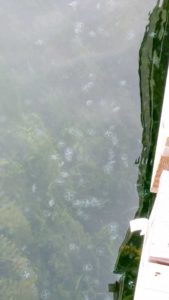Invasive species not uncommon in Ontario––but not on Manitoulin
SHEGUIANDAH BAY—Alison Aguonie of Sheguiandah First Nation couldn’t quite believe her eyes last Thursday as she peered over the Government Dock at Sheguiandah Bay, looking at what appeared to be jellyfish. Knowing her friends would never believe her, she quickly got to work, snapping photos and taking videos of the penny-sized creatures floating just below the service by the hundreds.
The Ministry of Natural Resources and Forestry confirmed to The Expositor that the creatures, known as freshwater jellyfish (or Craspedacusta sowerbyi) spied by Ms. Aguonie are jellyfish-like creatures that belong to the Class Hydrozoa.
“They are native to China but are now common in temperate climates across the globe; introductions are suspected to have occurred through movement of ornamental aquarium plants,” explained MNRF media spokesperson Jolanta Kowlaski. “They were discovered in the Great Lakes as early as the 1930s and inland lakes in Ontario in the 1980s. The “adult” form looks like a typical jellyfish with a whitish translucent bell shaped body and tentacles, only smaller. Large colonies of adults are often found in freshwater lakes in Ontario in late summer and fall, especially when water temperatures are warm. They are often present in lakes in their larval forms but are rarely detected until the right conditions exist (water temperatures of at least 25°C) and colonies of adults develop.” The adults feed on zooplankton and other small aquatic invertebrates.
In Ontario, adult colonies occur sporadically and it could be years between blooms. According to the site www.freshwaterjellyfish.org, “often, jellyfish will appear in a body of water in large numbers even though they were never reported there before. The following year they may be absent and may not reappear until several years later. It is also possible for the jellyfish to appear once and never appear in that body of water again.”

government dock in Sheguiandah. Native to China, the hydrozoa species are now quite common across the Great Lakes and Ontario, but are not so commonly seen on Manitoulin Island.
photos by Alison Augonie
“Their ecological impact is not well studied but it’s thought that during the years of adult blooms, they may impact zooplankton populations, which could affect other species that depend on the same food source,” Ms. Kowalski explained. “The jellyfish are not considered dangerous to people, even though their stings can paralyze small prey items.”
Sightings have been confirmed in many Ontario lakes, including nearby Anderson Lake, but none prior to Ms. Aguonie’s discovery in the Manitoulin Island area that this newspaper could locate.
Further information on the freshwater jellyfish can be found at http://freshwaterjellyfish.org/ including an email address to report sightings and distribution in Ontario. Video coverage of Ms. Aguonie’s Sheguiandah Bay jellyfish can be found on www.manitoulin.ca.





